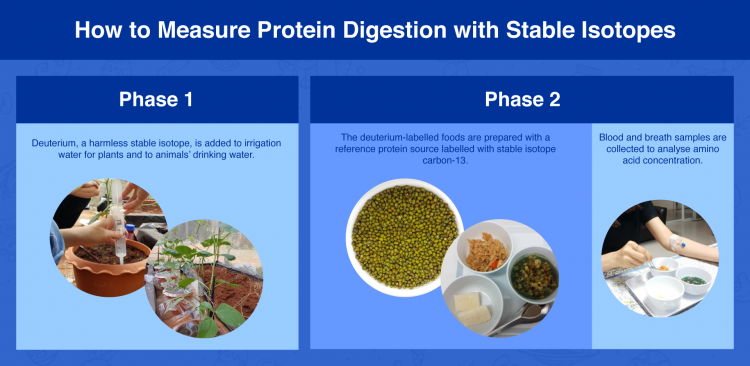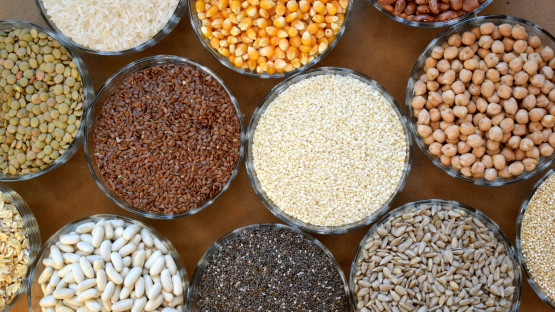
(Photos: W. Kriengsinyos/Mahidol University; Graphic: A. Vargas/IAEA)
The new dual stable isotope tracer technique measures protein digestion in a minimally invasive way through blood and breath analyses. In the first phase of the technique, amino acids in test food are labelled using the stable isotope deuterium, a form of hydrogen. Deuterium, which is harmless, is added to animals’ drinking water to study animal protein sources and to irrigation water for plant-based sources. Then, once the milk or legumes, for example, are ready for consumption, the deuterium-labelled foods are eaten along with a reference protein source labelled with carbon-13, a stable isotope of carbon.
Blood and breath samples are collected before and several times after the meal has been consumed to analyse amino acid concentration. “Digestibility is determined by the ratio of the labelled amino acids in the blood to those in the test meal. The recovery of carbon-13 from the breath samples provides a second indicator of protein digestion,” Owino explained.
The isotopic technique produces data aligned with the Digestible Indispensable Amino Acid Score (DIAAS), recommended by the Food and Agriculture Organization of the United Nations (FAO). “This technique offers a relatively less invasive human protocol for measuring protein digestibility consistent with all the criteria required for the DIAAS protein quality index,” said Sarita Devi, Lecturer at St. John’s Research Institute said. “It can measure the digestibility of multiple amino acids at once. It is also not affected by the endogenous protein in intestinal secretions that can confound the measurement of exogenous food protein digestion.”
The technique was developed as part of an IAEA coordinated research project (CRP) in 2015 and implemented in seven countries: Brazil, India, Jamaica, Mexico, Morocco, Pakistan and Thailand with technical support from France and the United Kingdom. Last week, experts virtually convened to share results from the CRP, including results from utilizing the isotope tracer technique.
“The CRP has developed and validated a novel, minimally invasive technique to assess protein digestibility and utilization from plant-based diets, as they are consumed by vulnerable populations, in regions habitually relying on plant-based diets,” said Maria Xipsiti, Nutrition Officer at the FAO. “New data on the true protein digestibility of legumes that have been generated by the CRP will contribute to the realization of a robust database of protein digestibility to be jointly managed by FAO and IAEA.”
Results gained from the technique will be presented at the International Symposium on Protein and Human Health in 2023 in Amsterdam, the Netherlands. “People require daily an amount of absorbed protein with an optimal amino acid balance, not just an amount of total protein,” said Paul Moughan, Distinguished Professor at Massey University, New Zealand. Moughan, who is also a Fellow Laureate, Riddet Institute New Zealand Centre of Research Excellence, presented at the meeting last week and is chair of the organizing committee for the Symposium in which the IAEA also sits. “Protein quality is of fundamental importance, particularly in low- and middle-income countries where protein and amino acids are often deficient, but also in wealthier countries for specific sectors of the population, like the elderly or people seeking to manage their weight.”








